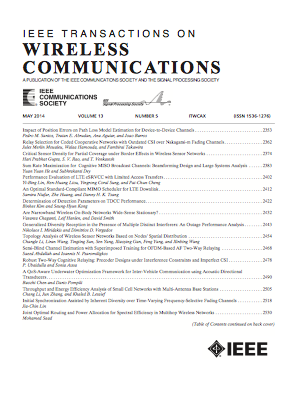带带宽约束的生成模型的扩散驱动语义通信
IF 10.7
1区 计算机科学
Q1 ENGINEERING, ELECTRICAL & ELECTRONIC
引用次数: 0
摘要
扩散模型由于其优越的生成能力,近年来在人工智能生成内容(AIGC)中得到了广泛的应用。与语义通信相结合,扩散模型用于诸如去噪、数据重建和内容生成等任务。然而,现有的基于扩散的生成模型没有考虑严格的带宽限制,限制了其在无线通信中的应用。针对带宽受限的生成模型,提出了一种基于扩展驱动的语义通信框架,该框架具有先进的基于vae的压缩技术。我们设计的架构采用扩散模型,其中信号通过无线信道的传输过程就是扩散中的正向过程。为了减少带宽需求,我们结合了一个下采样模块和一个基于变分自编码器的配对上采样模块,在接收器上进行了重新参数化,以确保恢复的特征符合高斯分布。在此基础上,推导了系统的损失函数,并通过综合实验对其性能进行了评价。我们的实验结果表明,在像素级指标(如峰值信噪比(PSNR))和语义指标(如学习感知图像补丁相似度(LPIPS))方面有显著改善。与深度联合源信道编码(DJSCC)相比,这些增强在压缩率和信噪比方面更为深刻。本文章由计算机程序翻译,如有差异,请以英文原文为准。
Diffusion-Driven Semantic Communication for Generative Models With Bandwidth Constraints
Diffusion models have been extensively utilized in AI-generated content (AIGC) in recent years, thanks to the superior generation capabilities. Combining with semantic communications, diffusion models are used for tasks such as denoising, data reconstruction, and content generation. However, existing diffusion-based generative models do not consider the stringent bandwidth limitation, which limits its application in wireless communication. This paper introduces a diffusion-driven semantic communication framework with advanced VAE-based compression for bandwidth-constrained generative model. Our designed architecture utilizes the diffusion model, where the signal transmission process through the wireless channel acts as the forward process in diffusion. To reduce bandwidth requirements, we incorporate a downsampling module and a paired upsampling module based on a variational auto-encoder with reparameterization at the receiver to ensure that the recovered features conform to the Gaussian distribution. Furthermore, we derive the loss function for our proposed system and evaluate its performance through comprehensive experiments. Our experimental results demonstrate significant improvements in pixel-level metrics such as peak signal to noise ratio (PSNR) and semantic metrics like learned perceptual image patch similarity (LPIPS). These enhancements are more profound regarding the compression rates and SNR compared to deep joint source-channel coding (DJSCC).
求助全文
通过发布文献求助,成功后即可免费获取论文全文。
去求助
来源期刊
CiteScore
18.60
自引率
10.60%
发文量
708
审稿时长
5.6 months
期刊介绍:
The IEEE Transactions on Wireless Communications is a prestigious publication that showcases cutting-edge advancements in wireless communications. It welcomes both theoretical and practical contributions in various areas. The scope of the Transactions encompasses a wide range of topics, including modulation and coding, detection and estimation, propagation and channel characterization, and diversity techniques. The journal also emphasizes the physical and link layer communication aspects of network architectures and protocols.
The journal is open to papers on specific topics or non-traditional topics related to specific application areas. This includes simulation tools and methodologies, orthogonal frequency division multiplexing, MIMO systems, and wireless over optical technologies.
Overall, the IEEE Transactions on Wireless Communications serves as a platform for high-quality manuscripts that push the boundaries of wireless communications and contribute to advancements in the field.

 求助内容:
求助内容: 应助结果提醒方式:
应助结果提醒方式:


